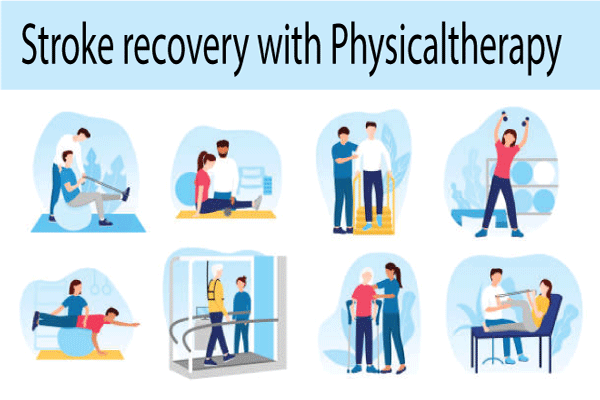Maximizing Stroke Recovery with Physical Therapy Exercises
What is a stroke?
A stroke is a medical condition in which a clot or a burst blood vessel blocks the supply of blood and oxygen to the brain. This can cause permanent brain damage, paralysis, or even death.
Common symptoms of stroke include weakness or numbness in the arms or legs, difficulty speaking or understanding, and difficulty seeing in one or both eyes.
There are two types of Strokes: first one is ischemic stroke and the second one is hemorrhagic stroke. An ischemic stroke occurs when a blood vessel supplying the brain becomes blocked, while a hemorrhagic stroke occurs when a blood vessel in the brain ruptures. Treatment for stroke depends on the type and severity of the stroke.
The importance of physical therapy exercises for stroke recovery
Physical therapy is a type of therapy that uses exercises and other techniques to help people regain strength, mobility, and balance. It is an essential part of stroke recovery, as it helps restore movement, strength, and coordination.
Physical therapy can help people with stroke improve their quality of life, as it helps them regain their independence and reduce the risk of falls. It can also help improve balance and coordination, reduce pain, and improve overall strength.
Physical therapy is also important for preventing further damage. This is because physical therapy can help strengthen weakened muscles and joints, reducing the risk of further injury.
Types of physical therapy exercises
The types of physical therapy exercises used for stroke recovery include:
- Range of motion exercises:
These exercises help improve flexibility and mobility in the affected body parts.
- Strength training exercises:
These exercises help strengthen weakened muscles, improve coordination, and reduce pain.
- Endurance exercises:
These exercises help improve endurance and stamina.
-Balance exercises:
These exercises help improve balance and reduce the risk of falls.
- Stretching exercises:
These exercises help improve flexibility and reduce muscle tension.
- Core strengthening exercises:
These exercises help strengthen the core muscles, which are important for balance and coordination.
Benefits of physical therapy for stroke recovery
Physical therapy is an important part of stroke recovery, as it can help improve mobility, strength, balance, and coordination. It can also help improve quality of life, as it helps people regain their independence and reduce the risk of falls.
In addition, physical therapy can help reduce pain and fatigue, improve sleep, and increase flexibility. This is because physical therapy can help strengthen weakened muscles and joints, reducing the risk of further injury.
Tips for maximizing stroke recovery with physical therapy exercises
Here are some tips for maximizing stroke recovery with physical therapy exercises:
- Start slow:
Don’t push yourself too hard too soon. Start with simple exercises and gradually increase the intensity as you get stronger.
- Keep it regular:
Make sure to do your physical therapy exercises regularly. This will help you build up strength and endurance and will help you stay motivated.
- Listen to your body:
Pay attention to your body and listen to it. If an exercise is too difficult or uncomfortable, stop and take a break.
- Ask for help:
Don’t be scared to ask for help if you need help at any point. A physical therapist can help you develop a personalized plan that is right for you.
Common mistakes to avoid when doing physical therapy exercises
Physical therapy exercises are an important part of stroke recovery, but it’s important to make sure you’re doing them correctly. Here are some common mistakes to avoid when doing physical therapy exercises:
- Not warming up:
Make sure to warm up before doing any physical therapy exercises.
- Not resting:
Make sure to take breaks and rest between sets.
- Not using proper form:
Make sure to use proper form when doing physical therapy exercises, as this will help you get the most out of your exercises.
- Not listening to your body:
Pay attention to your body and listen to it. If an exercise is too difficult or uncomfortable, stop and take a break.
The importance of a personalized physical therapy plan
Physical therapy is an important part of stroke recovery, but it’s important to make sure you’re doing the right exercises for your specific needs. A personalized physical therapy plan can help you maximize your recovery. A physical therapist can help you develop a personalized plan that is right for you.
What to look in a physical therapist for Stroke rehabilitation
When looking for a physical therapist, it’s important to make sure they have the right qualifications and experience. Look for a physical therapist who is certified in stroke rehabilitation, as this will ensure they have the necessary knowledge and experience to help with your recovery. It’s also important to make sure the physical therapist is experienced in working with people with stroke, as this will ensure they understand the particular needs of people with stroke.
Conclusion
Stroke is one of the leading causes of disability in the United States, with an estimated 795,000 people suffering from a stroke each year. Physical therapy is an essential part of stroke recovery, as it helps improve mobility, balance, strength, and coordination. In this blog post, we discussed the importance of physical therapy for stroke recovery, the different types of physical therapy exercises, and how to maximize stroke recovery with physical therapy exercises. Physical therapy is an important part of stroke recovery, but it’s important to make sure you’re doing the right exercises for your specific needs. A personalized physical therapy plan can help you maximize your recovery, as it will be tailored to your individual needs. It’s also important to make sure you’re working with a qualified and experienced physical therapist. If you or a loved one has suffered a stroke, physical therapy is an important part of recovery. With the right physical therapy plan and the right physical therapist, you can maximize your recovery and improve your quality of life.












No comments:
Post a Comment